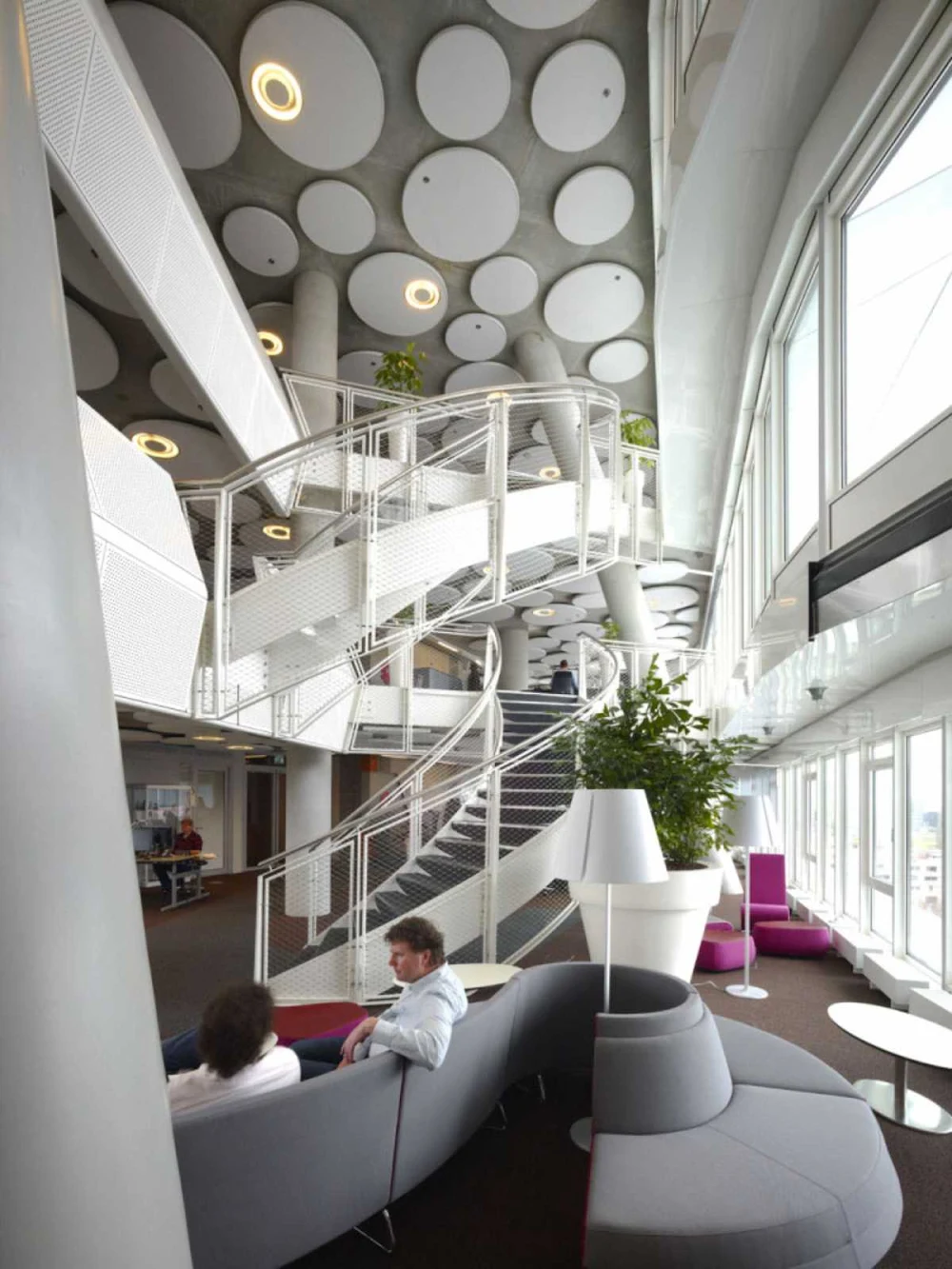
A new, 92 meter tall complex of soft, undulating curves marks the skyline of Groningen. This asymmetric, aerodynamic construction is set amidst small, ancient woodland, sheltering rare and protected species. the project includes the design, construction and financing of two public institutions; the national tax offices and the student loan administration.

The commission from the Rgd (National Buildings Service) includes, besides the architecture, the management and building maintenance and care of facilities and services for a period of 20 years. Accommodating 2,500 workstations, parking facilities for 1,500 bicycles and 675 cars in an underground garage, the building will be surrounded by a large public city garden with pond and a multifunctional pavilion with commercial functions.

The architecture aims to present these institutions with a softer, more human and approachable profile. Tall buildings are generally associated with mid-twentieth century modernism. Their harsh, businesslike exteriors contain powerful, inaccessible-seeming strongholds. by contrast, the Duo and Tax offices deliberately cloak a commanding public institution in an organic, friendlier and more future-oriented form.

The governmental office complex is built as part of a far-reaching form of public-private partnership (DBFMO) that is designed to effectuate on a more efficient use of public funds. the design, construction, financing, managing and maintenance of the building was hosted by one consortium consisting of Strukton, Ballast Nedam and John Laing.

This consortium won the competition for the project on the basis of a combination of esthetic, technical and financial criteria. Unstudio, as the architect of the project, collaborated with Lodewijk Baljon for the landscape design, Arup for the engineering and Studio Linse as the interior advisor.

The life-cycle approach of a Dbfmo contract requires that all relevant experts (designers, lawyers, installation specialists, financial specialists, facility specialists) are involved from the start of the project in order to find the best, most cost effective and environmentally-friendly solutions for the continued use and maintenance of the building.

This working methodology stimulates not only creative and innovative ideas, but facilitates a reduction of total costs over the entire contract period compared to the traditional means of contracting. in Ppp projects contracts are not awarded to the lowest bidder, but to the party with most effective solutions providing the best value for money.

The project is one of Europe’s most sustainable large new office buildings. the Rgd brief prescribed a future-proof building that couples flexibility and sustainability with an esthetic of sobriety. the architectural response to this has been to strive for an all-round understanding of the concept of sustainability, including energy and material consumption, as well as social and environmental factors.

Thus the sustainability manifests itself in reduced energy consumption (Epc 0.74), as well as significantly reduced material consumption. Bringing back the floor heights from 3.60 m to 3.30 m resulted in a total reduction of 7.5 m on the entire building, which also lessens the impact of the building on the surroundings. Both inside and outside the architecture generates a bio-climate that is beneficial to both humans and the local flora and fauna.

Sustainability and energy reduction have steered the design of the façade, which contains technical installations that are tailored to be durable and cause minimal environmental impact. the façade concept integrates shading, wind control, daylight penetration and construction in fin-shaped elements. These horizontal fins keep a large amount of the heat outside the building, reducing the requirement for cooling.




Location: Groningen, Holland Architect: UNStudio Project Team: Ben Van Berkel, Caroline Bos, Gerard Loozekoot With, Jacques Van Wijk, Frans Van Vuure, Lars Nixdorff And Jesca De Vries, Ramon Van Der Heijden, Alicja Mielcarek, Eric Den Eerzamen, Wendy Van Der Knijff, Machiel Wafelbakker, Timothy Mitanidis, Maud Van Hees, Pablo Herrera Paskevicius, Martijn Prins, Natalie Balini, Peter Moerland, Arjan Van Der Blick, Alexander Hugo, Gary Freedman, Jack Chen, Remco De Hoog, Willi Van Mulken, Yuri Werner, Machteld Kors, Leon Bloemendaal, Erwin Horstmanshof Interior: Studio Lines Structure And Installations: Arup Landscaping: Lodewijk Baljon Area: 31,134 m2 Volume: 215, 000 m3 Client: Dutch Government Buildings Agency (RGD) Photo: Ronald Tileman [n. 1-3-5-6]